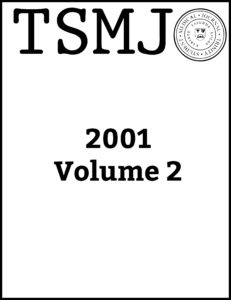Cervical Screening: What is the Evidence to Support the Introduction of a National Cervical Screening Programme?
Keywords:
MedicineDownloads
References
2 Greenlee RT, Murray T, Bolden S et al. Cancer statistics: 2000. Ca-A Cancer Journal for Clinicians 2000;50(1):7-33.
3 Laara E, Day NE et al. Trends in mortality from cervical cancer in the Nordic countries: association with organised screening pro- grammes. Lancet 1987;1(8544):1247-1249.
4 Miller A, Lindasy J. et al, Mortality from cancer of the uterus in Canada and its relationship to screening for cancer of the cervix, Int J of Cancer 1976;17(5):602-612.
5 Sigurdsson K. Effect of organised screening on the risk of cer- vical cancer: evaluation of screening activity in Iceland, 1964- 1991. Int J of Cancer 1993;54(4):563-570.
6 Cancer of the Uterine Cervix, National Cancer Registry, Ireland, 1996.
7 Cancer in Ireland 1997: A Summary, National Cancer Registry, Ireland 1997.
8 McPherson A, Anderson A, Women’s Problems in General Practice, Oxford University Press, 1986, 9:179-203.
9 Wilson JMG, Jungner G, Principles and practice of screening for disease, Geneva World Health Organisation, 1968; WHO pub- lic health paper 34.
10 Sackett DL, Straus SE et al. Evidence based medicine: How to practice and teach EBM, Churchill Livingstone, 2nd Edition,
Edinburgh, 2000.
11 Brinton LA. Epidemiology of cervical cancer–overview. IARC Scientific Publication, 1992;119:3-23.
12 Ley C, Bauer HM et al. Determinants of genital human papil- lomavirus infection in young women. Journal of the National Cancer Institute. 1991;88(14):997-1003.
13 Schiffman MH, Bauer HM et al. Epidemiological evidence showing that human papillomavirus infection causes most cervi- cal intraepithelial neoplasia, Journal of the National Cancer Institute 1993;85(12):958-964.
14 Reeves WC, Rawls WE, Brinton LA. Epidemiology of genital papillomaviruses and cervical cancer. Reviews of Infectious Diseases. 1993;11(3):426-439.
15 Barron BA, Richart RM. Statistical model of the natural histo- ry of cervical carcinoma II: Estimates of the natural transition time from dysplasia, Journal of the National Cancer Institute 1970;45(5):1025-1030.
16 Christopherson WM, Lundin FE, Mendez WM, et al. Cervical cancer control: a study of morbidity and mortality trends over a twenty-one-year period. Cancer 1976;38(3):1357-1366.
17 Johannesson G, Geirsson G, Day N. The effect of mass screen- ing in Iceland, 1965-1974, on the incidence and mortality of cer- vical carcinoma. I J of Cancer 1978;21(4):418-425.
18 Quinn M, Babb P, Jones J. et al. Effect of screening on inci- dence and mortality from cancer of cervix in England: evaluation based on routinely collected statistics. BMJ 1999;318:904-908.
19 Sasieni P, Adams J. Effect of screening on cervical cancer mor- tality in England and Wales: analysis of trends with an age period cohort model. BMJ 1999;318:1244-1245.
20 Macgregor JE, Campbello MK et al. Screening for cervical intraepithelial neoplasia in north east Scotland shows fall in inci- dence and mortality from invasive cancer with concomitant rise in preinvasive disease. BMJ 1994;308:1407-1411.
21 Stuart GCE, Parboosingh J. Implementation of Comprehensive Screening for Cervical Cancer in Canada: Impediments and Facilitators, J SOGC 1996;18:1241-1250.
22 Deacon JM, Yoon JSL et al. Cervical Cancer Screening and National Trends in Incidence and Mortality, St. Bartholomew’s Hospital NHST, The Epidemiology Team, CRC.
23 Gaffikin I, Blumenthal PD et al. Visual inspection with acetic acid for cervical cancer screening: Test qualities in primary care setting, University of Zimbabwe: JHPIEGO Cervical Cancer Project. Lancet 1999;353:869-873.
24 Meijer CJ, Rozendall L et al. Human papillomavirus and screening for cervical cancer: state of the art and prospects, Ned Tijdschr Geneeskd 2000;144(35):1675-1679.
25 International Agency for Research on Cancer Working Group on Evaluation of Cervical Cancer Screening Programmes, Screening for Squamous Cervical Cancer: duration of low risk after negative results of cervical cytology and its implication for screening policies, BMJ 1986;293(6548):659-664.
26 Kleinman JC, Kopstein A. Who is being screened for cervical cancer? American Journal of Public Health 1981;71(1):73-76.
27 Saway GF, Kerlikiwske K et al. Frequency of cervical smear abnormalities within 3 years of normal cytology. Obstetrics and Gynaecology 2000;96(2):219-223.
28 Sherlaw-Johnson C, Gallivan S, Jenkins D. Withdrawing low risk women from cervical screening programmes: mathematical modelling study. BMJ 1999;318:356-361.
29 Jenkins D, Gallivan S, Sherlaw-Johnson C. Compliance in screening programmes: High compliance essential in cervical screening programme. BMJ 1994;308:625-653.
30 McCrory DC et al. Evaluation of Cervical Cytology: Evidence Report/Technology Assessment Number 5, AHCPR, 1999; Publication No. 99-E010.
31 Hirsh PM, Lilford R et al. Efficacy of cervical smear collec- tion devices: a systematic review and meta-analysis. Lancet 1999;354:1763-1770.
32 Dyer C. Health authority loses cervical smear appeal. BMJ 1999;391:1391.
Downloads
Published
How to Cite
Issue
Section
License
Authors retain copyright and grant the journal the right of first publication with the work simultaneously licensed under a Creative Commons Attribution (CC-BY) 4.0 License that allows others to share the work with an acknowledgement of the work’s authorship and initial publication in this journal.
Provided they are the owners of the copyright to their work, authors are able to enter into separate, additional contractual arrangements for the non-exclusive distribution of the journal’s published version of the work (e.g., post it to an institutional repository, in a journal or publish it in a book), with an acknowledgement of its initial publication in this journal.



